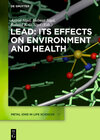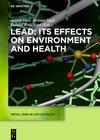
„(...) The well-balanced and comprehensive selection of aspects makes it the most valuable source of information on the present state of research in the field. This volume is an important addition to every library of a chemistry or biochemistry research institution, and it will serve as an essential reference work for every researcher in the field of metals in biology.“
Bernt Krebs in: Coordination Chemistry Reviews 361 (2018) 164–165
"(...) the three Sigels—Helmut, Astrid, and Roland—continuing their extraordinary service to the bioinorganic chemistry community. Volume 17 provides a snapshot of where we are in our understanding of the bioinorganic chemistry of lead and points to areas where more work is needed. It also provides a staggering number of references that the interested reader can use to deepen their knowledge of whatever facet of lead chemistry they want to pursue. As the editors state in the preface, the volume 'is rich on specific information, but it provides also basic insights that should help to promote further our understanding of the unique role which this toxic metal plays in the environment and in human health.'„
Rachel Narehood Austin in: Journal of Inorganic Biochemistry 176 (2017) 181-182
“(...) Volume 17 of Metal Ions in Life Sciences is the most current source of information on the fundamental biochemistry of lead, and a useful and timely summary of its impact on human health and the environment. It should be widely available and frequently consulted.„
Dean Wilcox in: Inorganica Chimica Acta 474 (2018) 117
“(...) This book will undoubtedly arouse the reader’s fresh attention to the toxic metal and deepen the understanding of its chemical properties, toxicity and underlying chemistry, and biological and global environmental effects. It is strongly recommended not only for researchers in relevant fields and those interested in the structure, function, and toxicity of metals but also for students aiming at bioinorganic, biogeochemical, biological, environmental, and related fields of chemistry.„
Osamu Yamauchi in: Transition Metal Chemistry 42 (2017) 275-277
“(...) The book presents a comprehensive review of the present knowledge of the role of lead in humans, flora and fauna, and the environment. It is well organized and well written. (...)"
Hubert Schmidbaur in: Zeitschrift für Naturforschung B 72 (2017) 527-528
Lead: Its Effects on Environment and Health
herausgegeben von Astrid Sigel, Helmut Sigel und Roland K.O. SigelVolume 17, entitled Lead: Its Effects on Environment and Health of the series Metal Ions in Life Sciences centers on the interrelations between biosystems and lead. The book provides an up-to-date review of the bioinorganic chemistry of this metal and its ions; it covers the biogeochemistry of lead, its use (not only as gasoline additive) and anthropogenic release into the environment, its cycling and speciation in the atmosphere, in waters, soils, and sediments, and also in mammalian organs. The analytical tools to determine and to quantify this toxic element in blood, saliva, urine, hair, etc. are described. The properties of lead(II) complexes formed with amino acids, peptides, proteins (including metallothioneins), nucleobases, nucleotides, nucleic acids, and other ligands of biological relevance are summarized for the solid state and for aqueous solutions as well. All this is important for obtaining a coherent picture on the properties of lead, its effects on plants and toxic actions on mammalian organs. This and more is treated in an authoritative and timely manner in the 16 stimulating chapters of Volume 17, which are written by 36 internationally recognized experts from 13 nations. The impact of this recently again vibrant research area is manifested in nearly 2000 references, over 50 tables and more than 100 illustrations (half in color). Lead: Its Effects on Environment and Health is an essential resource for scientists working in the wide range from material sciences, inorganic biochemistry all the way through to medicine including the clinic ... not forgetting that it also provides excellent information for teaching.




